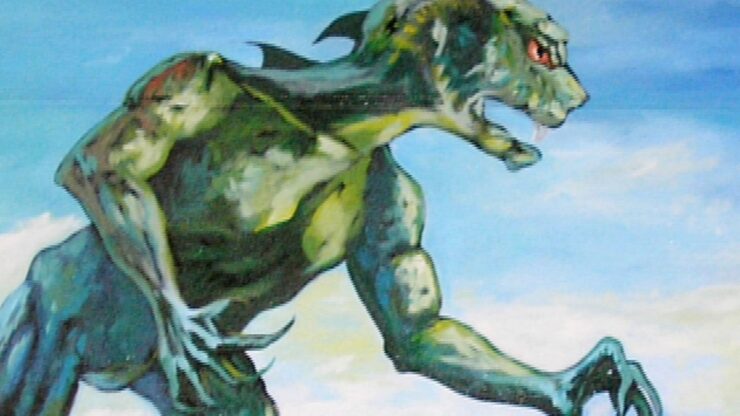Late in its second season, in an episode aired in 2008, our old friends at MonsterQuest tackled the tale of the Chupacabra. They examined the sightings in Puerto Rico in the mid-1990s, and not only looked at actual physical evidence found both there and in Texas from 2005 through 2007, but subjected it to scientific analysis.
This is prime cryptozoology. Cryptids like Bigfoot are an article of faith. There is no physical evidence to support their existence. No bodies, no bones. Plenty of casts of large, broad feet, but no one has captured or killed the animal that supposedly made the tracks, blurry videos notwithstanding.
The Chupacabra is a rarity. It has not been caught alive, but witnesses have preserved bodies of a creature that they claim is the cryptid. MonsterQuest applies actual science to the evidence, backed up by the prestige of university laboratories. New York University and Texas A&M are the real deal.
The episode does a good job of summing up what’s there. It covers the sightings in Puerto Rico, with video and photographic evidence and an interview with an eyewitness who claims to have encountered one on the balcony of his apartment. It was his height, he says, standing on two legs, with oval red eyes and four long fangs. Farmers claim that this creature or creatures slaughtered hundreds of livestock, including goats and chickens, draining them of blood but leaving the bodies.
The Latin American Chupacabra looks like a cross between a kangaroo and a gargoyle. The one sighted in the United States is quite different: a smallish quadruped with grey, hairless skin and—one trait it shares with the other variety—prominent fangs. One was shot and killed by a farmer in Elmendorf, Texas, and another by a man in Pollok; a farmer in Cuero found the carcass of yet another. Both farmers had had extensive predation among their livestock, with the animals drained of blood but not otherwise consumed.
Cryptozoologist Ken Gerhard and wildlife expert Lee Hales mount an expedition in Texas to trap one of these creatures, using camera traps, a cage, and a chicken for bait. (Poor chicken.) I think that’s mostly for show: as usual in these hunts, they don’t find what they’re looking for. The point is to make a display of trying. They do manage to trap a possum and a rather ticked off armadillo.
The main event is their examination of the bones of the animal killed in Elmendorf, and lab analysis, including DNA, of the various specimens. They even manage to sample a hair from a supposed nest of Chupacabras in Puerto Rico. Much is made of the fact that all of the Texas specimens are nearly or completely hairless, and that their skin is peculiarly tough, “like an elephant’s.”
Consensus is that the animal is some form of canine. There’s some fuss over the size of the fangs and the lack of hair, and some attempt to determine whether the hairlessness is due to disease, most likely mange. The kicker is the DNA. In every case but one, the genetic material is that of a domestic dog. That includes the sample from Puerto Rico. The exception, the Cuero specimen, is a hybrid of coyote and Mexican wolf.
When I saw the photos back when the story was new, I figured it was either a dog or a coyote with severe mange. I have seen coyotes in Arizona with the disease, and that’s what they look like. Weird leathery skin and all.
What’s interesting about the episode is how determined the witnesses are to believe that what they saw was a cryptid. Even the DNA evidence doesn’t convince them. In Puerto Rico, they speculate that a dog was out stealing chickens and ended up in a Chupacabra nest.
In Texas, same story. That couldn’t have been a dog or a coyote/wolf hybrid. It couldn’t have had mange. Nobody has ever seen mange that severe. It must be some sort of mutant. It has to be something unique and different.
And then there’s the question of why the Latin American version is so different from the one in the United States. The episode makes a point of talking to an expert in popular delusions. Benjamin Radford, author of Hoaxes, Myths and Manias, describes the way in which the media spread myths and fear. People tell stories, stories travel, people see what they want or expect to see. A shadow in the night becomes a creature out of legend—even if that legend is as recent as last year.
The legend that spread from Puerto Rico described a vaguely reptilian biped. In the United States, people shot animals that were supposedly preying on livestock, and those animals turned out to be hairless canines. Not naturally hairless—none of them tested out as the Mexican breed, the Xolo. According to the labs that examined the specimens, the animals had at some point had a full hair coat. I.e., mange or something similar.
The last question, which the episode never manages to answer, is how or why the supposed Chupacabra’s victims were drained of blood. It doesn’t explain the odd puncture wounds on the dead animals, either. Dogs and wolf hybrids don’t drink blood, and they eat their kills.
One possibility is vampire bats. They’re native to Mexico and South America and have been sighted in Southwest Texas. They are not found in Puerto Rico, though they have been seen in the far western Caribbean. But they’re quite small and they don’t drain their victims of blood.
So that remains a mystery. Maybe Princeton’s Chupacabra site is right in connecting it with cattle mutilations in North America outside of Texas, but that gets us into UFOs and aliens and various paranormal speculations. In short, nobody knows.










